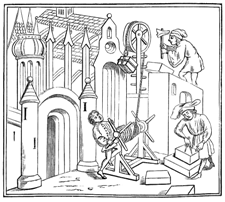The forgotten children of medieval London
Release Date 09 May 2011

Download the audio clip of Mary Lewis discussing her research into adolescents in the medieval period (right-click to save)
Teenagers today may think they have it tough but adolescents in medieval London had a much harder life.
In the early 1500s young migrant workers flocked into the capital in their thousands, often seeking apprenticeships. However, records show that many did not live to become adults. There was a dramatic rise in the mortality rates of 10 to 14-year-olds at this time, but their history has been largely ignored.
Dr Mary Lewis, from the Department of Archaeology at the University of Reading, has just been awarded £230,000 Leverhulme funding to investigate the, until now, forgotten group of adolescents.
Two thousand skeletons of young people from the early 16th Century have been discovered in two cemeteries - St Mary's Spittel in London and Barton-on Humber in Lincolnshire. For the first time researchers will be able to look at the adolescents' health in detail and discover what kinds of diseases and fractures they suffered.
"Despite the growing evidence that young apprentices and menial workers represent a clear and disadvantaged group in the past, their lives have been neglected in archaeology," said Dr Lewis. "Those buried in London's medieval cemeteries appeared to have a lot of fractures and respiratory infections, suggesting occupational hazards.
"This project focuses on the children that worked and died in late medieval London and compares their health to local adolescents from a market town in an attempt to define the experience of the medieval apprentice. Teenagers moving from rural areas into London where there were lots of migrants would have been exposed to different diseases for the first time."
During the three-year project, Dr Lewis will use samples to gauge the age at which children began employment and their quality of life, look at strontium and lead levels to identify young migrants in London in correlation with their age, sex and status, and develop osteological methods to record the onset of puberty in males and females.
ENDS
For more information please contact Rona Cheeseman, press officer, on 0118 378 7388 or email r.cheeseman@reading.ac.uk
Notes for editors
The University of Reading's Department of Archaeology boasts five Fellows of the British Academy among its members and was recognised in 2010 when the University was awarded the Queen's Anniversary Prize for Higher Education. In the most recent Research Assessment Exercise (2008), the department was ranked as the UK archaeology department with the highest proportion of world-leading research (40% 4* research).
The Department's six core areas of research cover the entirety of human history in Europe and the Near and Middle East from the last glaciation to AD1600. The world-leading research areas have a direct relevance for contemporary environmental and climatic change and in which the five Fellows of the British Academy play a major role. They include: the development of the first complex societies in the Near and Middle East since the last glaciation (Prof Steve Mithen FBA); coastal and wetland archaeology and the relationship between humans and the environment in prehistory (Prof Martin Bell FBA); later prehistoric societies in north-west Europe (Prof Richard Bradley FBA); urbanisation in the Roman World (Prof Michael Fulford FBA); Digital Data Capture in the Field, Database Development and Digital Dissemination World (Prof Michael Fulford FBA) and the archaeology of medieval gender, religion and belief (Prof Roberta Gilchrist FBA).
